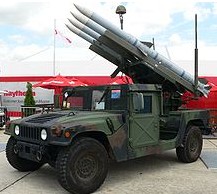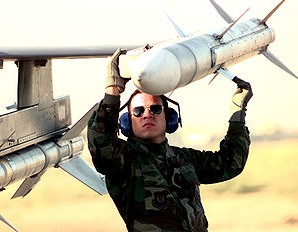
AIM-120 AMRAAM
Wikipedia | 2012-11-23 14:09
The AIM-120 Advanced Medium-Range Air-to-Air Missile, or AMRAAM (pronounced "am-ram"), is a modern beyond-visual-range air-to-air missile (BVRAAM) capable of all-weather day-and-night operations. Designed with the same form-and-fit factors as the previous generation of semiactive guided Sparrow missiles, it is a fire-and-forget missile with active guidance. When an AMRAAM missile is being launched, NATO pilots use the brevity code - Fox Three.
Origins
AIM-7 Sparrow MRM
The AIM-7 Sparrow medium range missile (MRM) was purchased by the US Navy from original developer Howard Hughes in the 1950s as its first operational air-to-air missile with "beyond visual range" (BVR) capability. With an effective range of about 12 miles (19 km), it was introduced as a radar beam riding missile and then it was improved to a semiactive radar guided missile which would home in on reflections from a target illuminated by the radar of the launching aircraft. It was effective at visual to beyond visual range. The early beam riding versions of the Sparrow missiles were integrated onto the F3H Demon and F7U Cutlass, but the definitive AIM-7 Sparrow was the primary weapon for the all-weather F-4 Phantom II fighter/interceptor, which lacked an internal gun in its early U.S. Navy, U.S. Marine Corps, and early U.S. Air Force versions. The F - 4 carried up to four AIM-7s in built-in recesses under its belly.
Although designed for non-maneuvering targets such as bombers, due to poor performance against fighters over North Vietnam, these missiles were progressively improved until they proved highly effective in dogfights. Together with the short range infrared guided AIM-9 Sidewinder, they replaced the AIM-4 Falcon IR and radar guided series for use in air combat by the USAF as well. A disadvantage to semiactive homing was that only one target could be illuminated by the launching fighter plane at a time. Also, the launching aircraft had to remain pointed in the direction of the target (within the azimuth and elevation of its own radar set) which could be difficult or dangerous in air-to-air combat.
AIM-54 Phoenix LRM
The US Navy later developed the AIM-54 Phoenix long range missile (LRM) for the fleet air defense mission. It was a large 1,000 lb (500 kg) Mach 4 missile designed to counter cruise missiles and the bombers that launched them. Originally intended for the straight-wing F6D Missileer and then the navalized version of the F-111B, it finally saw service with the Grumman F-14 Tomcat, the only fighter capable of carrying such a heavy missile. Phoenix was the first US fire-and-forget multiple launch radar-guided missile: one which used its own active guidance system to guide itself without help from the launch aircraft when it closed on its target. This in theory gave a Tomcat with a six-Phoenix load the unprecedented capability of tracking and destroying up to six targets beyond visual range, as far as 100 miles (160 km) away – the only US fighter with such capability.
A full load of six Phoenix missiles and its 2,000 pounds (910 kg) dedicated launcher exceeded a typical Vietnam-era bomb load; only one, two or four missiles were normally flown off the carrier, as a full load was too heavy for a carrier landing.[citation needed] Although highly lauded in the press, its service in the US Navy was primarily as a deterrent, as its use was hampered by restrictive Rules of Engagement in conflicts such as Operations Desert Storm, Southern Watch and Iraqi Freedom. The only reported combat successes were by Iranian Tomcats against Iraqi opponents. The US Navy retired the Phoenix in 2004 in light of availability of the AIM-120 AMRAAM on the F/A-18 Hornet and the pending retirement of the F-14 Tomcat from active service in late 2006.
ACEVAL/AIMVAL
The Department of Defense conducted an extensive evaluation of air combat tactics and missile technology from 1974–78 at Nellis AFB using the F-14 Tomcat and F-15 Eagle equipped with Sparrow and Sidewinder missiles as blue force and Aggressor F-5E aircraft equipped with AIM-9L all-aspect Sidewinders as the Red force. This Joint Test and Evaluaton (JT&E) was designated Air Combat Evaluation / Air Intercept Missile Evaluation (ACEVAL/AIMVAL).[citation needed] A principal finding was the necessity to produce illumination for the Sparrow until impact resulted in the Red Force being able to launch their all-aspect Sidewinders before impact thereby resulting in mutual kills. What was needed was Phoenix type multiple launch and terminal active capability in a Sparrow size airframe. This led to a Memorandum of Agreement (MOA) with European allies (principally the UK and Germany for development) for the US to develop an Advanced Medium Range Air-to-Air Missile (AMRAAM) with the USAF as lead service. The MOA also assigned responsibility for development of an Advanced Short Range Air-to-Air Missile to the European team - this would become the British ASRAAM.
Requirements

Surface-to-air mounting (shown: CATM-120C captive training variant)
By the 1990s, the reliability of the Sparrow had improved so much from the dismal days of Vietnam that it accounted for the largest number of aerial targets destroyed in Desert Storm. But while the USAF had passed on the Phoenix and their own similar AIM-47/YF-12 to optimize dogfight performance, they still desired the Navy's multiple-launch fire-and-forget capability for the F-15 and F-16. AMRAAM would need to be fitted on fighters as small as the F-16, and fit in the same spaces that were designed to fit the Sparrow on the F-4 Phantom. The European partners needed AMRAAM to be integrated on aircraft as small as the Sea Harrier. The US Navy needed AMRAAM to be carried on the F/A-18 Hornet and wanted capability for two to be carried on a launcher that normally carried one Sparrow to allow for more air-to-ground weapons.
The AMRAAM became one of the primary weapons air-to-air weapons of the new F-22 Raptor fighter, which needed to place all of its weapons into internal weapons bays in order to help achieve an extremely low radar cross-section. The U.S. Navy also needed to retire its old and worn out F-14 Tomcats, and then pass its Fleet Air Defense mission on to newer fighter planes: the F/A-18C/D Hornets and F/A-18E/F Super Hornets with medium-range air-to-air missiles. Also, the combat threats to the Navy's aircraft carrier task forces had changed dramatically following the collapse of the Soviet Union and its powerful navy and air force.
Development

First successful test at the White Sands Missile Range, New Mexico 1982
AMRAAM was developed as the result of an agreement (the Family of Weapons MOA, no longer in effect by 1990), among the United States and several other NATO nations to develop air-to-air missiles and to share production technology. Under this agreement the U.S. was to develop the next generation medium range missile (AMRAAM) and Europe would develop the next generation short range missile (ASRAAM). When the German ASRAAM seeker development ran into problems, the MOA was abrogated and this breakdown led to the U.S. developing AIM-9X Sidewinder and Germany the IRIS-T.[citation needed] Although Europe initially adopted the AMRAAM, an effort to develop the MBDA Meteor, a competitor to AMRAAM, was begun in Great Britain. Eventually the ASRAAM was developed solely by the British, but using another source for its infrared seeker. After protracted development, the deployment of AMRAAM (AIM-120A) began in September 1991 in U.S. Air Force F-15 Eagle fighter squadrons. The U.S. Navy soon followed (in 1993) in its the F/A-18 Hornet squadrons.
The eastern counterpart of AMRAAM is the somewhat similar Russian Air Force AA-12 "Adder", sometimes called in the West as the "AMRAAMski." Likewise, France began its own air-to-air missile development with the MICA concept that used a common airframe for separate radar-guided and infrared-guided versions.
Share this page




















